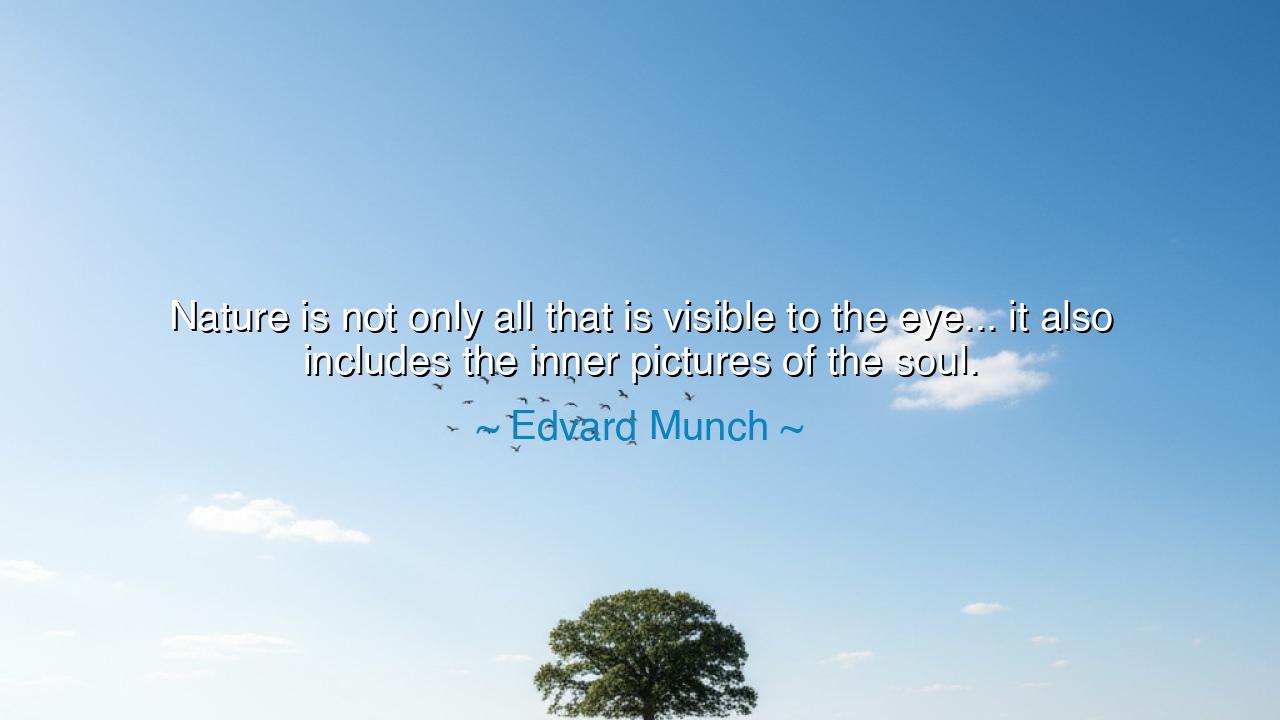
Nature is not only all that is visible to the eye... it also
Nature is not only all that is visible to the eye... it also includes the inner pictures of the soul.






Edvard Munch, the painter whose brush gave us The Scream and other haunting visions of humanity, once declared: “Nature is not only all that is visible to the eye… it also includes the inner pictures of the soul.” In these words lies a revelation that pierces through the boundaries of sight. For he proclaims that nature is not merely the mountains, rivers, trees, and skies, but also the landscapes within—the storms of grief, the dawns of hope, the quiet valleys of reflection. Thus, the human soul and the external world are not two separate realms, but mirrors of one another, each reflecting and shaping the other.
The origin of this thought rests in Munch’s own life and art. Tormented by illness, loss, and inner conflict, he did not paint nature as an indifferent backdrop, but as a living presence infused with human emotion. The crimson skies of The Scream were not simply clouds at sunset, but the embodiment of existential terror and despair. In this way, Munch reminds us that to see nature is not only to observe with the eye, but also to feel with the heart. What we perceive is colored by what we carry within us; the landscape becomes a canvas upon which the soul paints its own images.
This idea has been known since ancient times. The poet Homer described storms at sea that mirrored the wrath of gods and the fear of sailors. Chinese landscape painters of old filled their scrolls not with exact reproductions of rivers and peaks, but with dreamlike scenes that reflected the serenity or melancholy of the human spirit. And the Romantics of Europe—Wordsworth, Goethe, and Shelley—wrote of mountains and forests as if they were living beings, shaped by the moods of the observer. In all these traditions, as in Munch’s words, nature and soul are bound together, each completing the other.
The meaning is both emotional and heroic. Munch teaches us that to look at a forest or a sea is also to look inward. The external world awakens inner visions, and those visions give meaning to the external. When the heart is joyful, the sunrise is radiant; when the heart is heavy, the same dawn seems shrouded. To recognize this unity is to live more deeply, for it reminds us that we are not strangers in the universe, but participants in its song. Our inner world is not detached from nature—it is part of nature’s eternal tapestry.
This teaching also calls us to honesty. If the inner pictures of the soul are part of nature, then they deserve expression, not suppression. Munch himself suffered because he painted what others feared to confront: anxiety, despair, loneliness. Yet by giving form to these inner landscapes, he allowed the world to recognize them as natural and universal. In doing so, he showed that the human heart is not a weakness to be hidden, but a truth to be revealed. The mountain, the storm, the forest—they all have their inner echoes within us.
From this, a clear lesson shines: embrace both the outer and inner landscapes. Do not look at nature as if it were outside you; see it as part of you, and yourself as part of it. When you walk among trees, listen also to the whispers of your own heart. When you gaze upon the sea, recognize the tides of your own spirit rising and falling. And when you feel the inner storm, do not deny it—acknowledge that it, too, belongs to the great order of existence.
Practically, this means cultivating both observation and reflection. Take time each day to notice the world around you: the play of light, the song of birds, the movement of clouds. Then, ask what inner picture arises as you behold them. Write it down, paint it, sing it, or simply sit with it in silence. By doing this, you will weave together the visible and the invisible, the outer and the inner, until you see, as Munch did, that nature is not only what lies before your eyes, but also what breathes within your soul.
Thus, Edvard Munch’s words stand as a timeless command: do not separate the world without from the world within. For the two are one, joined like mirror and reflection. To see truly, you must feel. To feel truly, you must see. And in this union lies not only the meaning of art, but the meaning of life itself.






AAdministratorAdministrator
Welcome, honored guests. Please leave a comment, we will respond soon